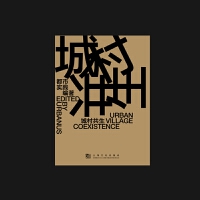
城村共生(汉英对照)
内容简介
深圳是一个崇尚规划设计的城市,规划者沿用现代主义的规划理念,讲究效率、功能、速度,用非常理性的方法规划出了现在的城市格局。但与此同时,另一个平行世界,缓慢、混乱、杂乱的城中村与城市如影随形,哪里有城市,哪里就隐藏着一些“天生”的城中村。这些被高速发展的城市所包围的原始村落,随着城市的发展、楼宇的长高、地价的攀升,也在进行着非正规的城市化进程。它也在生长,长高,加密。今天的深圳2000多万人中有近一半的人生活在这样非正规、非规划出来的城中村里。
走进这些街巷,它们拥挤且充满活力。有些人觉得这些地方很乱,应该被现代化的城市所清除;但另一些人觉得,这样的城市反而更充满动能,不仅为人们提供居住的地方,还为一些年轻人创造了最初的创业机会。随着城市的发展,很多城中村都受到了威胁,但实际上它们承载了深圳悠久的历史。今天深圳面临着一个很大的困境——发展空间受限,城中村就变成了未来发展的新的、深耕的潜在机遇。
本书是对第七届深双(南头)“城市共生”实验的学术梳理和延展,旨在于当下中国城市发展的拐点,秉持“城村共生”理念,修复城中村与地方历史的链接,重新定义和拓展已经固化的城、村二元分化的空间与社会场域的边界,构建一个关于城中村和城市未来的话语空间。不仅包括规划师和建筑师以及地理学、社会学、人类学、经济学、管理学等领域的学者,也包括租户、原村民与村集体、各级政府、地产、运营商的代表,还包括以城中村为背景进行创作的艺术家。汇聚的错综交叠的观点,以“城市档案”“非常经验”“特别实验”和“都市实践”四个章节为叙事线索,从文献研究的宏观叙事、人文观察的集体和个人记忆到多元的实践经验,展开各个学科视角下的城中村研究,力图兼顾各利益主体的代表性言论以及专业团队的介入实验和方法。本书在记录深圳城中村的发展变迁的基础上,探求城中村的空间特质,以及未来在城市更新历程中的各种可能性。全书不仅有写实的城中村空间描述,也有充满哲理与思辨的城市可能性,引发人们对深圳以及中国其他城市未来发展的思考。
这本书告诉你:
在深圳高速城市化过程中,城中村一直扮演着无法忽略的角色,蕴含了广泛的空间、经济、社会、文化议题。多年来自发建设的城中村被视为“城市毒瘤”,主流更新模式仅为拆除重建。自2005年起,都市实践持续进行城中村的研究和实践:2006年,主编出版《村·城 城·村》一书,探索拆除重建模式之外的另类改造策略,并推出针对深圳四个城中村的研究提案;2010年策划上海世博会城市最佳实践区的深圳馆,展出大芬村在地城市化的样本案例;2011年从湖贝古村的保护研究开始,到2016年与深圳业界和学者共同发起“湖贝120城市公共计划”,2019年湖贝古村被列入深圳首批公布的历史风貌区。2016年始,都市实践持续进行“南头古城保护与更新”的研究与实践,同时策划了以“城市共生”为主题的第七届城市建筑双年展。
近年,城中村所承担的城市职能被逐渐认可,被称为“城市器官”,更新政策转向综合整治,而多元杂糅的城中村正是抵抗同质化城市的另类样本。面对紧迫的现实,希望通过《城村共生》一书,扩展“2017年深双”的实验、总结多年的研究与实践成果,提供立体、多层次、多角度的叙事。希望在此中国城市化转型的当下,能够再次聚集各方声音,促进城市观念认知,探索城中村更新的多元模式,走向一个更加“共生的”城市未来。
Urban villages have played a substantial role in the rapid urbanization of Shenzhen, facilitating issues of space, economic, social, and culture. Over the years, Self-built urban villages have been referred to as “urban cancers” while demolition and redevelopment become the only main renewal model. URBANUS has started the study of and practices in urban villages since 2005. In 2006, URBANUS published the book Village/City City/Village exploring alternative renovation strategies in addition to demolition and redevelopment with research proposals of four urban villages in Shenzhen. The curation of the Shenzhen pavilion at the Urban Best Practice Area at the 2010 Expo showcased Dafen, an urban village as an local urban development paradigm. The preservation research of Hubei Ancient Village by URBANUS started in 2011, which led to the “Hubei 120 City Public Plan” initiated by URBANUS together with practitioners and scholars in Shenzhen. In 2019, Hubei Ancient Village was included in the first batch of the Protection Catalogue of Historical Areas in Shenzhen. Beginning in 2016, Nantou Old Town Conservation and Regeneration became one of URBANUS’s research and practice focus. In the meantime, URBANUS curated “Cities, Grow in Difference”, the 2017 Bi-City Biennale of Urbanism\Architecture (2017 UABB) in Nantou Old Town.
In recent years, the significance of urban villages has been recognized that it was regarded as the “urban organ.” The renewal policy has shifted to comprehensive remediation. Inclusive and diverse urban villages are the alternative paradigms against the unitary and homogeneous city. Facing such a pressing reality, Urban-village Coexistence attempts to provide a comprehensive, multi-layer, and multi-perspective narrative by elaborating on the experiment at 2017 UABB and summarizing years of research and practice conclusions. It is the hope that at the pivotal moment of Chinese urbanization, the book serves as an agent to gather the voices of different people, and to promote an understanding of urban concepts that explore a diversified urban village regeneration model for a co-existing urban future.
作者简介
作者:
URBANUS都市实践创建于1999年,是当今中国最具影响力的独立建筑师团队之一,有多个建成项目成为城市生活地标。它既是一个事务所,更是一种理念,旨在从广阔的城市视角和特定的城市体验中解读建筑的内涵,紧扣中国的城市现实,以研究不断涌现的当下城市问题为基础致力于建筑学领域的探索。
自成立以来参与了大量重要的建筑和城市设计项目,已建成包括深圳罗湖美术馆、大芬美术馆、华?美术馆、雅昌艺术中心、土楼公舍、美伦公寓&酒店、回酒店、南方科技大学图书馆、体育馆,中广核大厦、深业上城LOFT、华侨城创意文化园改造、南头古城保护与更新、山西五龙庙环境整治、唐山博物馆、唐山城市规划馆、京杭大运河创想中心、北京世园会植物馆、西侯度古人类遗址保护、北京四合院改造系列等。
都市实践的设计既尊重城市现有的空间肌理,又能在城市中恰如其分地表达出自身的个性。一系列建成作品成为城市生活新地标,多次获得重要建筑奖项:如WA设计奖、THE PLAN奖、亚洲建筑师协会奖、中国建筑传媒奖、美国《建筑实录》年度全球设计先锋并获得阿卡汗建筑奖提名。
都市实践聚焦中国城市现状,积极推进对高密度城市类型、旧城历史街区和城中村保护与再生等课题的研究与实践,以其对城市的社会和历史结构的敏锐、整合复杂的城市环境中潜在的空间和社会文化资源,进而准确找到有效的应对策略而受到国际关注。
Since its founding in 1999, URBANUS has been recognized as one of the most influential independent architecture practices in China. Many of its built works have become landmarks for urban life. URBANUS has conducted a series of research projects, including typologies for hyper-density, the preservation and regeneration of historical urban areas and urban villages, focusing on contemporary Chinese urban phenomena. URBANUS has received international recognition for its sensitivity to urban, historical, and social structures, its ability to mobilize and integrate potential spatial and social resources, and its effectiveness in responding to the complexities of the urban environment.


